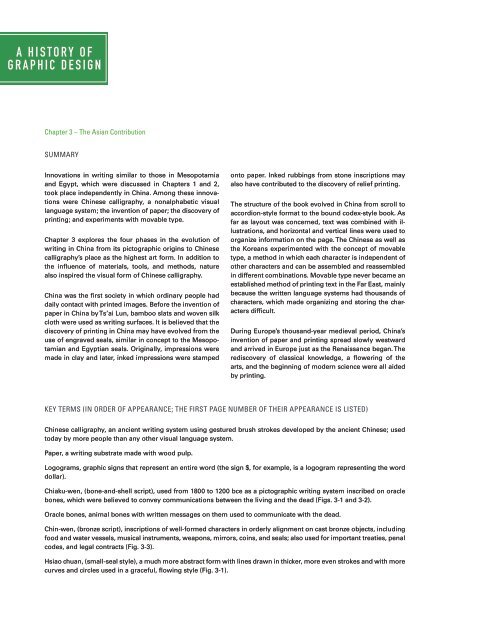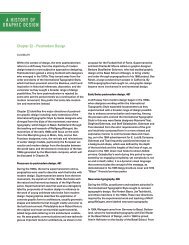Week 12 The Asian Contribution - A History of Graphic Design
Week 12 The Asian Contribution - A History of Graphic Design
Week 12 The Asian Contribution - A History of Graphic Design
You also want an ePaper? Increase the reach of your titles
YUMPU automatically turns print PDFs into web optimized ePapers that Google loves.
A HISTORY OF<br />
GRAPHIC DESIGN<br />
Chapter 3 – <strong>The</strong> <strong>Asian</strong> <strong>Contribution</strong><br />
SUMMARY<br />
Innovations in writing similar to those in Mesopotamia<br />
and Egypt, which were discussed in Chapters 1 and 2,<br />
took place independently in China. Among these innovations<br />
were Chinese calligraphy, a nonalphabetic visual<br />
language system; the invention <strong>of</strong> paper; the discovery <strong>of</strong><br />
printing; and experiments with movable type.<br />
Chapter 3 explores the four phases in the evolution <strong>of</strong><br />
writing in China from its pictographic origins to Chinese<br />
calligraphy’s place as the highest art form. In addition to<br />
the influence <strong>of</strong> materials, tools, and methods, nature<br />
also inspired the visual form <strong>of</strong> Chinese calligraphy.<br />
China was the first society in which ordinary people had<br />
daily contact with printed images. Before the invention <strong>of</strong><br />
paper in China by Ts’ai Lun, bamboo slats and woven silk<br />
cloth were used as writing surfaces. It is believed that the<br />
discovery <strong>of</strong> printing in China may have evolved from the<br />
use <strong>of</strong> engraved seals, similar in concept to the Mesopotamian<br />
and Egyptian seals. Originally, impressions were<br />
made in clay and later, inked impressions were stamped<br />
onto paper. Inked rubbings from stone inscriptions may<br />
also have contributed to the discovery <strong>of</strong> relief printing.<br />
<strong>The</strong> structure <strong>of</strong> the book evolved in China from scroll to<br />
accordion-style format to the bound codex-style book. As<br />
far as layout was concerned, text was combined with illustrations,<br />
and horizontal and vertical lines were used to<br />
organize information on the page. <strong>The</strong> Chinese as well as<br />
the Koreans experimented with the concept <strong>of</strong> movable<br />
type, a method in which each character is independent <strong>of</strong><br />
other characters and can be assembled and reassembled<br />
in different combinations. Movable type never became an<br />
established method <strong>of</strong> printing text in the Far East, mainly<br />
because the written language systems had thousands <strong>of</strong><br />
characters, which made organizing and storing the characters<br />
difficult.<br />
During Europe’s thousand-year medieval period, China’s<br />
invention <strong>of</strong> paper and printing spread slowly westward<br />
and arrived in Europe just as the Renaissance began. <strong>The</strong><br />
rediscovery <strong>of</strong> classical knowledge, a flowering <strong>of</strong> the<br />
arts, and the beginning <strong>of</strong> modern science were all aided<br />
by printing.<br />
KEY TERMS (IN ORDER OF APPEARANCE; THE FIRST PAGE NUMBER OF THEIR APPEARANCE IS LISTED)<br />
Chinese calligraphy, an ancient writing system using gestured brush strokes developed by the ancient Chinese; used<br />
today by more people than any other visual language system.<br />
Paper, a writing substrate made with wood pulp.<br />
Logograms, graphic signs that represent an entire word (the sign $, for example, is a logogram representing the word<br />
dollar).<br />
Chiaku-wen, (bone-and-shell script), used from 1800 to <strong>12</strong>00 bce as a pictographic writing system inscribed on oracle<br />
bones, which were believed to convey communications between the living and the dead (Figs. 3-1 and 3-2).<br />
Oracle bones, animal bones with written messages on them used to communicate with the dead.<br />
Chin-wen, (bronze script), inscriptions <strong>of</strong> well-formed characters in orderly alignment on cast bronze objects, including<br />
food and water vessels, musical instruments, weapons, mirrors, coins, and seals; also used for important treaties, penal<br />
codes, and legal contracts (Fig. 3-3).<br />
Hsiao chuan, (small-seal style), a much more abstract form with lines drawn in thicker, more even strokes and with more<br />
curves and circles used in a graceful, flowing style (Fig. 3-1).
A HISTORY OF<br />
GRAPHIC DESIGN<br />
Chen-shu or kai-shu, (regular style), has been in continuous use for nearly two thousand years. Every line, dot, and nuance<br />
<strong>of</strong> the brush can be controlled by the sensitivity and skill <strong>of</strong> the calligrapher. It is considered the highest art form<br />
in China, more important even than painting (Fig. 3-5).<br />
Li, the prehistoric character for the three-legged pot, which is now the word for tripod (Fig. 3-6).<br />
Tao, the cosmic spirit in Chinese culture that operates throughout the universe in animate and inanimate things.<br />
Chop, a seal made by carving calligraphic characters into a flat surface <strong>of</strong> jade, silver, gold, or ivory. <strong>The</strong> raised surface<br />
is inked and the image is transferred to paper by stamping. (Fig. 3- 10).<br />
Cinnabar, a substance used to make a paste-like red ink for stamping.<br />
Woodblock printing, pages 40, 45: <strong>The</strong> negative space around characters and images are carved away from the wood.<br />
Ink is then applied to the wood, and it is pressed onto paper or other substrates to print the image (Fig. 3-16).<br />
Relief printing, <strong>The</strong> spaces around an image on a flat surface are cut away, the remaining raised surface is inked, and<br />
the inked image is transferred to the paper.<br />
Dharani, Buddhist charms printed and placed in pagodas to help lengthen one’s life and eventually lead to paradise<br />
(Fig. 3-14).<br />
Diamond Sutra, the oldest surviving printed manuscript, consisting <strong>of</strong> seven sheets <strong>of</strong> paper pasted together to form a<br />
scroll conveying Buddha’s revelations to his elderly follower Subhuti (Fig. 3-15).<br />
Accordion-style book, folded book resembling a scroll that was folded like a railroad timetable instead <strong>of</strong> rolled.<br />
Codex-style book, stitched book with sequences <strong>of</strong> two pages <strong>of</strong> text printed from one block, then folded down the<br />
middle with the unprinted side <strong>of</strong> the sheet facing inward and the two printed pages facing out.<br />
Pen ts’ao, a medical book on herbs with illustrations and calligraphy used for headings and a graphic design grid system<br />
used to separate the text into sections shown in the center <strong>of</strong> the right-hand page (Fig. 3-17).<br />
Movable type, in Asia, single characters made individually in a mixture <strong>of</strong> clay and glue and arranged side by side to<br />
compose full lines <strong>of</strong> text (Fig. 3-19).<br />
KEY PEOPLE AND THEIR MAJOR CONTRIBUTIONS (IN ORDER OF APPEARANCE; THE FIRST PAGE NUMBER OF THEIR<br />
APPEARANCE IS LISTED)<br />
Ts-ang Chieh, inspired in about 1800 bce to invent writing by contemplating the claw marks <strong>of</strong> birds and footprints <strong>of</strong><br />
animals, then developing elementary pictographs <strong>of</strong> things in nature.<br />
Prime Minister Li Ssu (c. 280–208 bce), charged with designing the new standardized writing style, hsiao chuan.<br />
Li Fangying ( 1695–1754 ce), wrote and illustrated the Album <strong>of</strong> Eight Leaves, showing how the vividly descriptive<br />
strokes <strong>of</strong> a bamboo brush join calligraphy, painting, poem, and illustration, into a unified communication (Fig. 3-7).<br />
Ts’ai Lun, the eunuch and high governmental <strong>of</strong>ficial credited with inventing paper.<br />
Pi Sheng (1023–1063 ce), Chinese alchemist who developed the concept <strong>of</strong> movable type.
















